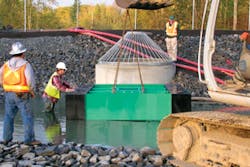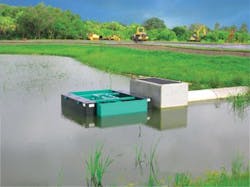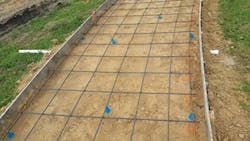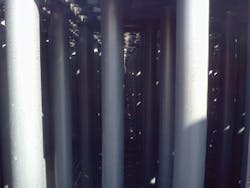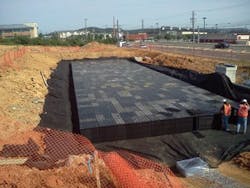Think of flood control and the image of a raging river may come to mind. But small floods—from creeks overflowing their banks or urban stormwater runoff in areas that don’t have adequate drainage—also cause problems. Fortunately, there are some effective products that deliver the solutions needed to prevent or control flooding.
Bellingham Airport
Some people say that flying is for the birds, but when birds flock around airports danger can take wing. One recent example is the “Miracle on the Hudson”: Veteran pilot Chesley Sullenberger successfully landed an Airbus 320 on the Hudson River after birds hit the plane’s engines.
Because many incidents of planes encountering birds end with crashes and subsequent loss of life, the Federal Aviation Administration (FAA) actively works to keep birds away from airports. One way the agency has found to deter birds is for airports to remove the natural and stormwater ponds that attract them.
Bellingham International Airport in Bellingham, WA, had this type of potential safety hazard. Its 7-acre stormwater pond had been a necessary installation for the airport to be in compliance with local and state stormwater regulations. Numerous waterfowl and other species of birds visited the pond daily.
Any solution that would remove the pond’s attraction to birds also had to keep the airport in compliance with stormwater regulations. Finding that solution—one that reduced the 7-acre pond to a fast-draining 2-acre pond—fell to the engineering firm of Reid Middleton of Everett, WA.
“The project started in August 2011 and finished in October of that year. We were able to reduce the detention pond to less than 30% of its original volume,” says Mark Davis, project engineer for Reid Middleton.
Thirsty Duck installed in a pond
Reid Middleton’s solution came from an appropriately named company, Thirsty Duck, which is located in Trinity, FL. Thirsty Duck’s drainage products are based on groundbreaking flow-control technology that operates on the principle of buoyancy.
A Thirsty Duck device drains water at a nearly constant rate. That means that detention volume can be less and the size of stormwater systems can be reduced by as much as 50%, leaving more usable land on a project site. The device can also reduce peak flows and reduce fluctuations in discharge rates to sensitive streams and receiving waters.
Thirsty Duck’s technology comes in two product series. The TD Series is designed for applications needing discharges less than 1.5 cfs (675 gpm). It works via an expanding high-grade polyurethane bellows.
The ER Series, which was installed in the Bellingham International Airport’s stormwater pond, is designed for applications needing more than 1.5 cfs. It fits into standard precast inlet boxes and features a telescoping tube operation.
“The project can handle up to a 100-year storm event. For Washington state, if [a detention pond] is more than 10 acre-feet of volume, you have to install a dam as an additional safety measure,” explains Davis.
He adds, “We had to install a spillway that is 40 feet wide and extends 100 feet down. It is lined with gabion walls and rock.”
At the time of year when the project was done, weather was not a factor, but another challenge came from “a lot of wetland species growing there. We had to dredge the muck out and lay geotextile fabric as a secure base for the rock to go on,” says Davis.
Keeping the fabric steady while the rock was poured on was not easy. Fortunately, there were no steep slopes to deal with.
“We hadn’t, as a company, used Thirsty Duck before, but the Bellingham Airport had used it on other projects,” says Davis. “The original owner of Thirsty Duck worked for the city of Bellingham, and he was well known there.”
Davis likes Thirsty Duck because “it reduces the volume of water building up instantly. Normally you have to build up 2 to 3 feet of water to push the [increasing] water out. The water quantity goes out so quickly.”
Now, instead of a placid pond to fly down to and float on, birds that fly near the Bellingham International Airport see “a sea of rock, with a slight slope toward a pit where the Thirsty Duck is. Everything is rock-lined, so no vegetation can come up,” says Davis.
He adds that the Thirsty Duck is still working fine. There are no concerns about it becoming corroded because it’s made of plastic resin.
This stormwater project at Bellingham International Airport cost about $2 million. It was paid for with a grant from the FAA.
Mitered Drain in a Texas playground. Sidewalks were raised to
aid drainage.
Improving the Playground
Poor drainage near playground areas can quickly result in problems for the children who want to play there. Standing water draws mosquitoes, and muddy areas are unsightly and sometimes unsafe.
Setex Construction Company of Beaumont, TX, won the contracts to install sidewalks near the playgrounds in three city parks. The projects’ architect, Don LaBiche of The LaBiche Architectural Group in Beaumont, specified drains (model 3MD3P-G) by Mitered Drain of Windsor, CA, to solve drainage issues.
Mitered Drain (patent pending) was developed by a civil engineer to provide an innovative, cost-effective alternative to conventional drop inlets and catch basins. The oval-shaped drains are especially suited for use in hard-to-drain areas where lack of grade difference makes design difficult.
A Mitered Drain is flexible. It can be used as an inlet or an outlet and adapts to almost all types of pipe. With a Mitered Drain, water drains directly to the flow line of the pipe.
Mitered Drain can be connected directly to the end of the pipe. This capability allows for swales of greater lengths, longer surface flow, and greater biotreatment and groundwater infiltration.
In March and April of this year, Setex worked on two city parks in Port Arthur, TX. Lincoln Park, the larger of the two, involved “the renovation of an existing park with a new sidewalk around the playground,” says Nathan Rivers, a project manager with Setex.
“By raising the area for the sidewalk, we created a low area on the side where the play area is,” explains Rivers. “To funnel water outside to the drain and prevent mud holes, we placed a Mitered Drain every 15 feet on both sides of the sidewalk, which was 725 linear feet.”
Over 6 inches of dirt, the crew added 1 foot of selected fill material. Then the sidewalk, 5 inches thick, was put in place. There was about 8 inches between the top of the sidewalk’s surface and the top of the drains.
The Mitered Drains were connected with 3-inch PVC pipe. “We put the PVC pipe under a fall protection [rubber mat] surface,” says Rivers. “The surface was aligned with adjacent concrete, but it’s porous so the PVC liner captures water and drains it on the other side of the sidewalk.”
Rivers says this was the first experience the crew had using the Mitered Drain, “but it was very easy to go in. Mitered Drain’s slope makes it easy to go flush with the sod, and it glued to the PVC pipe easily.” He adds that because the drains are even with the ground, they won’t be damaged by mowers.
Weather could have been a problem. “We had a very wet winter in Port Arthur, and we had lots of rain delays. We completed the job on a Friday. Then we had two and a half inches of rain over a five-hour period, but on Monday everything was dry when the park opened,” says Rivers.
At Port Arthur’s Montrose Park Setex installed the same Mitered Drain every 15 feet on both sides of the new sidewalk around the play area. This sidewalk, also 5 inches thick, measured 1,200 linear feet.
Tank interior.
Sextex’s third project with Mitered Drains was at Lions Park in Sabine Pass, TX. The drains were placed in the same manner. The sidewalk around this park’s play area measured 163 linear feet.
University of Tennessee
The University of Tennessee at Chattanooga lies in the southeastern section of the state. The terrain of the campus is hilly, so much so that the university’s students—and, no doubt, many of the faculty—refer to the main cross-campus walkway as “Cardiac Hill.”
“There is a 30 foot vertical rise from Heritage Plaza up to Oak Street,” says David Payne, project manager with Ross/Fowler Architecture in Knoxville, TN, the design firm for the project that improved the walkway and handled the overall UTC renovation.
The existing walkway was removed and replaced with one that is accessible to everyone—that is, compliant with requirements of the Americans with Disabilities Act (ADA). The project took approximately 10 months, from October 2012 to August 2013, with some time out for rain delays.
The accessible walkway goes through the heart of the UTC campus, from Heritage Plaza to Oak Street. It consists of a series of sloped sidewalks and steps with handrails.
A series of trench drain runs were required at the base of each run of steps to prevent heavy rains from flooding the sloped ramps. To meet this goal, modular trench channel drain systems from ACO Polymer Products were installed.
ACO drain systems come in 2-, 4-, 8-, and 12-inch internal widths and are available with up to 130 feet of built-in continuous slope or neutral/no slope. The company manufactures trench drain systems from polymer concrete, stainless steel, mild steel, cast iron, fiberglass, and molded plastics.
ACO’s KlassikDrain with ductile iron wave grates provided increased hydraulic capacity so that the runs of steps were not only ADA compliant but also comfortable to step on as well as architecturally pleasing. For this project, 44 linear feet of K200 (8-inch internal width) and 97 linear feet of K100 (4-inch internal width) drains were installed.
The most challenging part of the project was “making sure what we were doing would achieve the ADA tolerances that were required for stormwater drainage, to be sure we held stormwater onsite and released it slowly,” says Payne.
Preconstruction and post-construction flows had to be the same. “We had to make sure we didn’t add any water,” notes Payne.
He says the grates, which were also used in the Heritage Plaza portion of the project, “are attractive and meet ADA standards, due to their openings’ size. They must be one-fourth-inch width, maximum, and the grates must be perpendicular to the direction of travel, so canes or wheelchairs cannot get caught in them.”
He adds, “They’re cost effective. The contractor wanted to use them, and we had no problem with that.”
StormTanks in the area that will become a retail parking lot.
From Farm to Corporate Center
A different type of drainage problem presented a challenge in the once-rural countryside of Berks County, PA. McCarthy Engineering Associates of Wyomissing, PA, came up with a creative solution to meet the challenge and please the firm’s client, Kohl’s department store, also in Wyomissing.
The land in question had once been a 636-acre farm. Over a period of 20 or so years, the property was developed into Spring Ridge Corporate Center, with eight large office buildings.
Other development followed, including a hotel, a medical center, and a new shopping center. Area residents lamented the loss of their rural landscape. For years they voted against approving development of the last remaining section of the property as a shopping center.
Finally, Kohl’s won approval to build on the site.
Because space was limited, complying with state and municipal stormwater regulations and the National
Pollutant Discharge Elimination System (NPDES) permit would not be easy.
The standard best management practices (BMPs) would not be applicable because the property is in an area with extensive karst geology. Sinkholes are not unusual.
For these reasons, “We geared away from infiltration,” explains Kevin Marmas, senior project engineer with McCarthy Engineering Associates. “The township is very well known for karst geology and active sinkhole incidents.”
He adds, “Most of the time [for stormwater projects in the region] infiltration is not recommended. We use detention ponds as well as underground detention systems.”
The solution the McCarthy engineers devised involved installing stormwater detention basins beneath the section of the property that would become the parking lot for Kohl’s customers. The basins selected were StormTank ST-36 models from Brentwood Industries of Reading, PA.
Together the two basins—each a separate unit—hold 18,859 cubic feet of stormwater runoff. One StormTank is slightly larger than the other. The StormTanks were installed in August 2012.
“The StormTanks were lined with an impervious PVC liner, so the system’s whole goal was for detention. Everything goes into them and then back through the storm sewer system,” says Marmas.
Brentwood Industries’ StormTanks feature an open-module design with no internal walls or partitions. They are manufactured in heights of 18, 24, 33, and 36 inches.
Stackable StormTanks are designed to exceed an HS-25 load rating. Their stackabilty and this degree of strength were important, because the only space available was beneath the parking lot. The area had to bear the weight of customers’ cars, delivery trucks, and emergency vehicles if they were ever needed.
Marmas says that the project’s biggest challenge was “being constricted with space to place detention and stormwater facilities. We didn’t go with infiltration. We had to use detention for pollutant removal.”
The project was designed, says Marmas, “to handle runoff from a 100-year storm event.”
One StormTank feature he likes is the system’s void capacity. “It’s 95 to 97%, so that means it is basically completely open with lots of room for storage.” That figure compares to 40% for some other systems, “which allows you to decrease the footprint.”
Another useful StormTank feature is that “you get the option with the liner to specify impermeable or permeable,” he notes.
The Kohl’s project was not the first time that McCarthy engineers had requested StormTanks. “There have been a few projects we specified StormTank on, especially when we were restricted with space,” Marmas says.
Holding Back Floodwaters
In some areas of the US, in seasons with heavy rain or snow melt, even very good drainage systems are not sufficient enough to prevent flooding. Controlling the flooding or holding flood waters at bay until they have time to recede can be accomplished by using an old-fashioned product: sandbags.
Even if there is an adequate supply of dry sand, sandbags present a major problem: the slow, tedious work of filling them. Even a large number of city workers and community volunteers may not have sufficient time to get enough sandbags filled to stop flooding that occurs rapidly.
One solution is the SandMaster, a sandbagging machine made by Barrier Systems of Monroe, WA, with additional offices in Hawaii and California. SandMasters are designed to fit on most common types of machines that a city or company doing outdoor work would already own.
The SandMaster 20, which fills and securely closes 20 bags at a time, fits all but the smallest skid-steers. The SandMaster 26 model attaches to many types of backhoes and loaders. It fills and securely closes 26 bags at a time.
In a 24-hour period, depending on the model, one SandMaster can fill 15,000–18,000 bags with sand. In an eight-hour work day the SandMaster 20 can fill 4,800 bags and the SandMaster 26 can fill 6,240 bags.
The machines can fill and place multiple sandbags where they are needed, saving transportation costs and time. Each sandbag is filled to the same weight and consistency.
The SandMaster 20 is the model used by Martinez Bros. Landscaping and Irrigation of El Paso, TX. The company provides sandbags for El Paso Water Utilities, the city’s water company.
“We have the contract for three years. We provide all the sandbags needed,” says Carlos Reyes, project manager for the landscaping firm. He adds, “We filled 170,000 sand bags for them last year.”
El Paso, one of the southernmost cities in the United States, lies along the Rio Grande River in far western Texas. The river divides the US from Mexico.
“June to September is our rainy season,” says Reyes, adding that “about 50%” of the city is subject to flooding.
During these summer months, winds carrying moisture from the Pacific Ocean and the Gulf of Mexico are forced to rise because of the mountains that surround El Paso (orographic lifting). The resulting cooling, combined with high daytime temperatures, causes thunderstorms, some of which bring serious flash flooding.
During flooding season, El Paso Water Utilities provides free sandbags to any resident who requests them. People can go to any of five stations around the city to pick up their sandbags.
Martinez Brothers bought its SandMaster 20 in 2013. Crew members attach it to a skid-steer to use.
Reyes says that maintenance of the SandMaster has been minimal. “We haven’t had any major problems with is. We change the oil regularly.”
Installation is quick and easy. “You remove the little bucket at the front of the skid-steer and put the machine on,” Reyes explains. “It takes about a minute to install, and removal takes the same time.”
SandMaster users must use sandbags designed and provided by Barrier Systems. These bags have string closures that are longer than standard.
“You do have to use their bags, but we find it’s cost effective,” says Reyes, who usually staffs the sandbagging crew with four people.
The company’s SandMaster20 measures about 8 by 5 feet, so when it’s not being used, “it’s no problem to store,” Reyes says.
Preventing or controlling flooding by using sandbags or the right drainage system for the specific location saves time and money. In both cases, preventing or controlling flooding means preventing or controlling erosion.